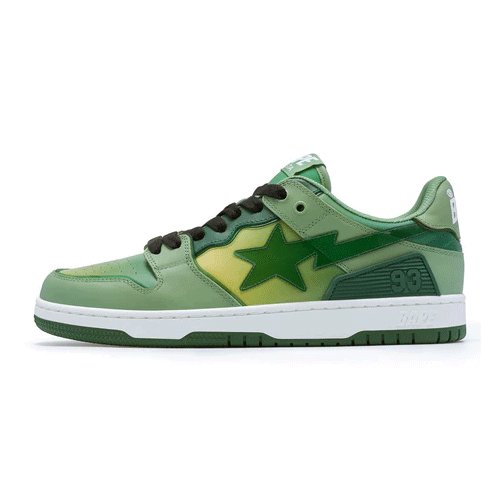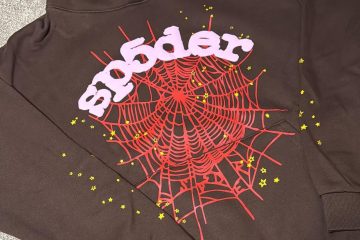If you’ve been even remotely tuned into the streetwear scene, you’ve likely heard the name Bapesta whispered in reverent tones. Originally launched in the early 2000s by Japanese fashion powerhouse A Bathing Ape (BAPE), the Bapesta sneaker did more than just make waves—it redefined how Eastern and Western streetwear cultures collide. Born from bold design, celebrity endorsement, and a fearless disregard for convention, the Bapesta has become a cultural artifact, not just a sneaker.
At first glance, the Bapesta may look familiar—and that’s no coincidence. Its silhouette draws a direct comparison to Nike’s Air Force 1. However, the Bapesta unique star logo (the iconic “STA”), glossy patent leather finish, and electric colorways quickly set it apart as something entirely its own. Despite the controversies around its design, Bapesta found an identity and fanbase that continues to grow two decades later.
The Bapesta Backstory: Nigo’s Vision and Controversy
Behind the Bapesta’s origin is Nigo, the founder of BAPE and a visionary in streetwear. Inspired by American pop culture, hip-hop, and sneakers, Nigo sought to create a product that mirrored global influence through a distinctly Japanese lens. When he introduced the Bapesta in 2002, it raised eyebrows for its similarity to the Air Force 1, but also curiosity. Was it a knockoff or a reinterpretation?
Nigo never denied the influence. Instead, he leaned into it, calling the Bapesta a tribute to American sneaker culture. In an industry often fixated on originality, Nigo’s transparency turned what could’ve been a scandal into a statement. The Bapesta was not just a sneaker—it was a commentary on fashion appropriation, reinvention, and reinterpretation.
Design and Aesthetic: What Makes a Bapesta a Bapesta?
The Bapesta is bold by nature. The first thing that sets it apart is the STA logo, a lightning bolt-like star replacing the Nike Swoosh. It screams individuality while maintaining a sense of familiarity. Then there’s the color palette—wildly vibrant, often mismatched, and typically finished in glossy patent leather. Think neon greens with bubblegum pinks, or metallic purples paired with chrome detailing. There are no rules.
The construction of the Bapesta emphasizes flash over subtlety. Every element, from the oversized laces to the high-gloss finish, is designed to attract attention. For sneakerheads who appreciate the artistry in sneaker design, Bapestas are collectibles. Limited edition collaborations, camo prints exclusive to BAPE, and Japan-exclusive releases have kept the hype alive for over 20 years.
Celebrity Co-Signs and Cultural Influence
No sneaker achieves legendary status without the co-sign of pop culture’s elite. The Bapesta’s rise to global recognition was fueled by early adopters in the hip-hop world. Pharrell Williams, Kanye West, Soulja Boy, and Lil Wayne were all spotted rocking Bapestas at the height of their influence. In the early 2000s, a Bapesta was more than a shoe—it was a signal of status, taste, and connection to the cutting edge of culture.
Pharrell and Nigo collaborated under the Billionaire Boys Club label, bringing even more Western exposure to BAPE. Kanye’s limited-edition Bapesta, which featured his “Dropout Bear,” became one of the most sought-after sneakers of the era. These celebrity partnerships did not just promote the shoe—they made it aspirational.
The ripple effect was undeniable. Bapesta became a fixture in music videos, red carpet events, and hip-hop lyrics. “I got me some Bathing Apes,” Soulja Boy rapped in 2007, cementing the shoe’s place in mainstream music and youth culture.
Bapesta Today: Revival, Collaborations, and Modern Appeal
Fast forward to the 2020s, and the Bapesta is experiencing a revival. In an era of nostalgia-driven fashion and Y2K aesthetics, the Bapesta feels fresher than ever. New drops are now met with online raffles, long queues, and resell prices soaring above retail.
BAPE has also expanded the Bapesta line with fresh reinterpretations—low-tops, high-tops, and collabs with global brands. Recent collaborations with Coach, Marvel, Undefeated, and Comme des Garçons show the sneaker’s versatility and cross-market appeal. The fusion of American comic book prints, luxury fashion tones, and streetwear edge has made modern Bapestas appealing to both new-school fashion fans and OG collectors.
These re-releases not only honor the original DNA of the shoe but also adapt it for contemporary tastes. More minimal colorways, premium materials, and sustainability-driven production hint at BAPE’s evolving identity in a rapidly shifting fashion landscape.
Why Bapesta Still Matters in 2025
In a sneaker market flooded with limited releases and collabs, it’s hard for any brand to stand out. But Bapesta remains a symbol of rebellion, self-expression, and cultural fusion. It isn’t just about nostalgia; it’s about boldness. Unlike minimalist sneaker trends, Bapesta embraces loud colors, over-the-top finishes, and unfiltered design.
Fashion trends come and go, but Bapesta’s staying power lies in its defiance of trend. It was loud when minimalism ruled, flashy when others played it safe, and honest about its inspirations in a world that often denies them. Whether you’re a die-hard sneaker collector or a newcomer curious about streetwear history, the Bapesta deserves a spot on your radar—and maybe in your closet too.
How to Style Bapesta: Streetwear Looks That Pop
Styling a pair of Bapestas is a lesson in creative freedom. Their vivid colorways mean they’re often the centerpiece of any outfit. Pair them with baggy cargo pants, oversized graphic tees, and statement accessories for a classic Y2K streetwear look. For a more elevated approach, match a neutral Bapesta with cropped tailored pants, a clean hoodie, and minimalist outerwear to balance flash and finesse.
Don’t shy away from pattern mixing or color clashing. Bapestas are made to be seen—let your outfit echo that energy. For sneakerheads posting their ‘fit checks’ on social platforms or attending sneaker conventions, Bapestas are an automatic conversation starter.
The Resale Market and Collectibility of Bapesta
If you’re lucky enough to score a rare or early pair of Bapestas, you’re sitting on fashion gold. Vintage Bapestas from the 2000s, especially those linked to celebrities or collaborations, are highly coveted on resale platforms. Original Kanye West or Pharrell Williams designs can fetch thousands depending on condition and rarity.
Collectors value not only the shoe but also the cultural moment it represents. Owning a pair from the Nigo era is a piece of fashion history. As BAPE continues to grow globally, the original drops become even more significant in the eyes of resellers and fans alike.
Final Thoughts: The Legacy of Bapesta in Fashion
The Bapesta is more than just a sneaker—it’s a symbol of innovation, audacity, and global fashion synergy. From Tokyo’s Harajuku streets to the stages of the BET Awards, the Bapesta has been a constant presence in shaping how sneakers intersect with identity and creativity.
In a world where originality often means blending and remixing, Bapesta was ahead of its time. Its bold aesthetic, strong cultural ties, and unapologetic approach to design have made it not just relevant, but timeless.





